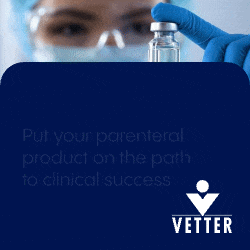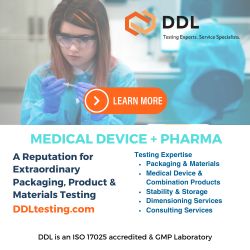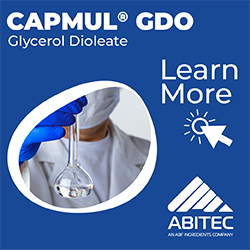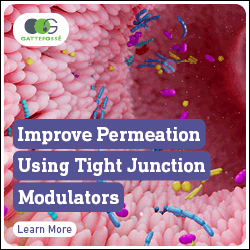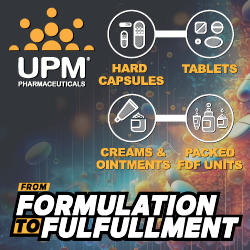Issue:September 2022
SOLUBILITY ENHANCEMENT - How Microparticles are Opening Doors to New Solutions for Oral Drug Delivery
INTRODUCTION
Solubility enhancement is still one of the main challenges in oral small molecule drug product development. A very high number of new chemical entities emerging from drug discovery is poorly soluble. Important therapeutic areas with poorly soluble new chemical entities include cancer, cardiovascular, infectious diseases, diabetes, and diseases affecting the central nervous system (CNS).1 There are existing manufacturing technologies on the market to formulate poorly soluble drugs.2 Amorphous solid dispersions (ASDs) are a very successful approach and show the strongest growth among all solubility-enhancing technologies.3 ASDs are mainly produced using hot-melt extrusion or spray-drying processes that are well-established manufacturing techniques in the market.4
However, these processes cannot currently overcome all hurdles. Some Active Pharmaceutical Ingredients (APIs) are sensitive to high temperatures and high mechanical stress, and at the same time, have a low solubility in suitable organic solvents.5 These limitations can lead to low spray solution concentrations. Moreover, poor particle engineering control in these processes results in cohesive powder with inferior flow properties, so that additional down-streaming steps are needed after the formation of the ASD.6 However, this can stress the amorphous system and risk destabilization of the physical form. Also, handling of high potent APIs can be challenging using established manufacturing technologies.
Another important aspect to consider is final pharmacokinetic performance, which is not only dependent on the formulation, but can also be influenced by the manufacturing process.7 Therefore, the orchestration of formulation and process development is key for success. In pharmaceutical drug product development, lab-scale processes often cannot be scaled-up seamlessly to commercial scale, creating risk of changing pharmacokinetic performance. In addition, the amount of API available from discovery is often insufficient to enter first-in-human studies with long process development steps. Therefore, a seamless transition from pre-clinical to clinical development is key for success.
Even though spray-dried dispersions, hot-melt extrusion, and solubilizing excipients are the most common techniques for solubility enhancement, the pharmaceutical sector needs further innovations to maximize the benefits of ASDs. The use of oral microparticles offers a potential solution.
The following focuses on the use of microparticles for solubility enhancement of oral small molecules and how this approach can address the challenges in pharmaceutical formulations.
MICROPARTICLES & THEIR SUCCESSFUL USE IN PHARMACEUTICAL FORMULATIONS
Microparticles, which consist of API and polymer, have been widely studied for decades as an attractive formulation technology for controlled and extended drug release. They are mostly developed as parenteral formulations. Following injection, microparticles continuously release the API and maintain the drug level within the therapeutic window over time to provide long-term therapeutic effects.8 The API is encapsulated inside the polymer matrix. Following administration, the polymer dissolves or degrades in the human body, then the API comes out from the microparticles.
There are several examples of commercial microparticle products, including for the alleviation of osteoarthritis pain and the palliative treatment of advanced prostate cancer. They usually come as a kit that includes the injection vehicle, the needle, and the microparticles. The microparticles are typically packaged in a vial or a prefilled syringe. They are re-suspended in the injection vehicle for administration. These products can have an extended release over different periods, for example, formulations for 1 or 2 weeks, 1 month, 3 months, or 6 months are available. The longest sustained-release product currently on the market is 10 months.
MICROPARTICLE ENCAPSULATION TECHNOLOGIES
There are three microencapsulation technologies used to make commercial microparticle products; solvent evaporation, solvent extraction, and phase separation.9 Whichever technology used, it is important to understand the polymer properties. These play a vital role in creating the matrix structure of microparticles that affect the uptake of water, which then penetrates into microparticles, finds the API, dissolves the API, and then releases it.
The internal structure of microparticles varies depending upon the polymer and the API properties and the process conditions. In some cases, the API crystallizes during the microencapsulation process, particularly in products developed for extended release. In other cases, the API is just dispersed in the polymer matrix. For solubility enhancement and ASDs, the APIs need to be molecularly dispersed in the microparticle matrix so that they have higher solubility for improved absorption.
Looking in more detail at a continuous solvent extraction process, API, polymer, and solvent are combined to form a dispersed phase, while surfactant is dissolved in water to form a continuous phase. There are several factors that have to be considered when preparing the dispersed phase, ie, the solubility of the polymer in the organic solvent and whether the API is dissolved or just suspended in the polymer solution.
Other factors affecting microparticle preparation include the preparation method for a single or a double emulsion, and how the chemical stability of the API in the dispersed phase is maintained.
The next stage is to take the dispersed phase and the continuous phase through the emulsion generator in which the emulsion droplets are formed. As soon as the emulsion droplets emerge out of the emulsion generator, the solvent is extracted out of the emulsion droplets.
There are different types of emulsion generators available for making microparticles, such as static mixer, rotor stator, and Evonik-patented emulsion generators. Once the flow in the equipment has started, the dispersed phase is mixed with the continuous phase, and emulsion droplets are formed. By using different emulsion generators and different process conditions, microparticles of all different sizes can be prepared. It is possible to create microparticles from 20 μm to 50 μm, which is very attractive for injectables. In addition, microparticles below 10 μm for uptake by macrophages and above 100 μm for oral applications can be realized. Depending upon the application, the target microparticle size range can be adjusted.
SUCCESSFUL SCALE-UP
A vital part of any drug development is the move from the laboratory to commercial-scale manufacturing. The major tasks include scale-up of the process, production according to good manufacturing practices (GMP), as well as the regulatory evaluation of the process.
At early stages, only small batches of several grams are required; the process can be run in the fume hood, and several steps of the process can be run manually. This provides the flexibility to try different process concepts and troubleshoot very quickly.
When the project is moved to a later stage of development, such as clinical and commercial manufacturing, the batch size is at kilogram scale, and GMP production needs to be carried out to maximize the product safety and quality. The process also requires automated manufacturing and online controls that ensure high quality over the whole process. For scale-up in a continuous process, the tubing and equipment size can be increased to increase the flow rate of disperses. This continues proportionally so that the time for making a batch stays substantially the same as the process is scaled-up. Timing affects the properties of microparticles so this is important.
If the unit operation is longer, the properties of the polymers, the API, or the microparticles may change over time when the process is run. It is very important to keep good control on the process flow, eg, if longer unit operations have to be used or longer time processing, the time change can have an effect on the properties of microparticles. It is important to consider the product’s recovery to make sure you have an efficient production process for manufacturing.
MICROPARTICLE TECHNOLOGY FOR ORAL SOLUBILITY ENHANCEMENT
The microparticle process was used to leverage the several advantages of the process to produce ASDs for solubility enhancement. Those advantages comprise the creation of uniform particle-engineered particles with a controlled target particle size at high yield, the free flowability of the resulting ASDs, as well as a seamless transition from pre-selection to clinical and commercial through mathematical modelling.
For this process, the crystalline poorly soluble API is dissolved with a polymeric carrier in a suitable organic solvent. At the same time, an aqueous phase is prepared. Both liquids are pumped into an emulsification device to produce perfectly round emulsion particles. After drying, this creates a free-flowing, ready-to-fill product.
CASE STUDIES
The performance of the new oral microparticle process technology has already been proven with several poorly soluble drugs.
Telmisartan
Telmisartan is a cardiovascular drug with a high melting point of 269°C.10 It is practically insoluble in water and is administered with a daily dose of 20 to 80 mg. EUDRAGIT® E PO was selected as polymeric carrier and processed together with telmisartan using the new process technology to create uniform round microparticles of size 200 μm (d50). Telmisartan remained in an amorphous state determined via XRPD after processing and 3 months stability at 25°C/60%rh and 30°C/65%rh. Dissolution was measured in a USP apparatus II at 150 rpm in 500-ml acetate buffer 4.0 for 2 hours. Pure telmisartan showed no solubility, and the oral microparticles increased the dissolution rate up to 80% in comparison to the crystalline drug. The results show that dissolution could not only be increased decisively with the new process compared to the pure crystalline drug after processing, but also was stable after 3 months storage at 25°C/60%rh and 30°C/65%rh (data not shown).

Bexaroten
Bexaroten is a cancer drug with a high melting point of 230°C. It is practically insoluble in water and administered with a daily dose of 75 mg. EUDRAGIT® E PO was selected as polymeric carrier, EUDRAGIT® RL PO was added to increase the Tg of the polymeric system and thus, physically stabilize the resulting microparticles. Bexaroten and both polymers were processed using the new process technology to create uniform round microparticles of size 163 μm (d50). Bexaroten remained in an amorphous state determined via XRPD. Dissolution was measured in a USP apparatus II at 150 rpm in 700 ml HCl for 15 mins followed by buffer pH 6.8 up to 3 hours. The results show that dissolution could be increased decisively with the new process compared to the pure crystalline drug and also compared to a marketed soft gel capsule. It is known from literature that ASDs tend to show stronger solubility enhancement than soft gel formulations, which was also visible in this case.

To investigate the more relevant performance comparison between an ASD prepared by the new microparticle process and spray drying, spray-dried dispersions with exactly the same formulation were prepared in house. For this purpose, the emulsion-based microparticles, the spray-dried dispersions, the crystalline API, and the marketed soft gel capsule were further investigated in an in-vivo study with beagle dogs. The bexarotene pharmacokinetic parameters in male beagle dog plasma following single oral administration showed a superior pharmacokinetic performance of the ASD prepared via the new microparticle process.
In summary, microparticles are a very beneficial process technology to create ASDs and thus, overcome solubility issues of small molecules for oral application. The microparticle process that is well-known from marketed parenteral drug products could be successfully transferred to an oral application and employed to manufacture stable ASDs using APIs with high melting points and poor aqueous solubility. With this new process, pharmacokinetic performance could be improved compared to standard processes known in the market.
CONCLUSION
Microparticles offer a potential extra avenue for successful solubility enhancement. However, when developing microparticles, it is crucial to understand and control the critical material attributes and the critical process parameters because they play an important role in establishing microparticle properties. Formulation and process expertise is important for designing a microparticle formulation, scaling up, and commercialization.
We have illustrated that oral microparticles offer a unique solution to solubility enhancement when it comes to the formulation of challenging APIs, overcoming processing hurdles and optimizing pharmacokinetic performance. The new process facilitates the solubilization of highly challenging compounds, creates free-flowing powder through lean process with advanced particle-engineering control, and leverages the full therapeutic potential of an API. Finally, a seamless transition from pre-clinical formulation development to commercial manufacturing is key for fast first-in-human trials and successful final drug product development.
REFERENCES
- Globaldata 2022.
- P. Tran et al., Overview of the Manufacturing Methods of Solid Dispersion Technology for Improving the Solubility of Poorly Water-Soluble Drugs and Application to Anticancer Drugs, Pharmaceutics, 11; 3, 2019.
- M. Crew, BIOAVAILABILITY ENHANCEMENT – Analysis of the Historical Use of Solubilization Technologies, Drug Development & Delivery, 2014.
- S.V. Jermain et al., Amorphous solid dispersions and nanocrystal technologies for poorly water soluble drug delivery – An update, International Journal of Pharmaceutics 535; 379–392, 2018.
- M. Simões, Hot-melt extrusion in the pharmaceutical industry: toward filing a new drug application, Drug Discovery Today, 24; 9, 2019.
- J. Henriques, QbD approach to downstream processing of spray-dried amorphous solid dispersions – a case study, Pharmaceutical Development and Technology, 26; 3, 2021.
- S. Huang & R.O. Williams 3rd, Review Article: Effects of the Preparation Process on the Properties of Amorphous Solid Dispersions, AAPS PharmSciTech 2017.
- W. Li et al., Clinical translation of long-acting drug delivery formulations, Nature Review Materials, 2022.
- S. Freitas et al., Microencapsulation by Solvent Extraction/Evaporation: Reviewing the State of the Art of Microsphere Preparation Process Technology, Journal of Controlled Release 102(2):313-32, 2005.
- R. Evans et al., Holistic QbD approach for hot-melt extrusion process design space evaluation: Linking materials science, experimentation and process modeling, European Journal of Pharmaceutics and Biopharmaceutics 141;149–160, 2019.

Dr. Jessica Mueller-Albers joined Evonik’s Health Care business line in 2010 and is currently working as Strategic Marketing Director for oral drug delivery solutions. Before taking over her current position, she was Group Leader for Drug Delivery, focusing on the development and analytics of new oral and parenteral platform technologies for the pharma and food industry as well as the development of cell culture media. She has held different positions in application service and formulation development of oral dosage forms and worked for a contract manufacturer, where she gained experience in developing solid and semi-solid dosage forms, product transfer, manufacturing of clinical-trial medication, GMP, and high potent handling. She earned her degree in Pharmacy from the University of Halle/Saale and her PhD from the University of Duesseldorf, where she specialized on melt extrusion of poorly soluble drugs. She is the author of several research papers, book chapters, and patents.

Dr. Yiming Ma joined Evonik’s Health Care business line in 2018 and is currently Senior R&D Scientist at Evonik’s Birmingham Laboratories, focusing on parenteral complex formulation development. Prior to joining Evonik, she was a Group Leader at WuXi AppTec for preformulation and developability assessment to support new drug development. She has extensive formulation, analytical, and process experience in the pharmaceutical industry with a focus on complex formulation development, such as microparticles and nanoparticles. She earned her PhD in Pharmaceutical Science and Nanotechnology from the University of Queensland, Australia, where she specialized in the development of targeted drug delivery systems based on microparticles and nanoparticles for cancer treatment. She has authored several publications in top tier pharmaceutical journals.

Alexander Bernhardt joined Evonik’s Health Care business line in 2017 and is currently working as Head of the Drug Delivery & Applications group in the R&D department in Germany. He is an expert in the development of parenteral and oral drug delivery technologies and has extensive experience in the management of innovation and customer projects. He earned his degree in Pharmacy from the University of Regensburg, Germany, and gained experience in the field of drug nanosuspensions of poorly water-soluble drugs during his PhD at the University of Muenster, Germany.

Michael Damm is an Innovation Project Manager at Evonik, focusing on chemical technology. He began working at the company in 1992 and has expertise in process technology, particle engineering, as well as solubility and bioavailability enhancement of BCS II to IV drugs. He has built up a wealth of knowledge on the development of parenteral, inhalative, and oral drug products.
Total Page Views: 6640













